| |
 Dream Industries, Rap Pages, 6-99
Dream Industries, Rap Pages, 6-99 |
In the section on ads
as forms of communication, we learned that many factors taken
together create the message of ads.
Here we will consider how ads speak to us by appealing to fantasies,
our hopes and dreams. They suggest that our future life and personality
can be different if we buy their products.

|
Review the Five Principles of Media Literacy
. Be sure to apply 1 and 5 to this work on how ads appeal to viewers'
fantasies.
You and your class partner have been assigned some of the numbered
items below. In a computer lab, complete the activities your pair is assigned
and answer the questions. Bring your notes to class!
Quotes are taken from your article by John Berger, from Ways of Seeing.
1. Discuss the meaning of the following quote
and write a paraphrase of it.
Remember that 'publicity' means advertising.
| Publicity can never really afford to be about the
product or opportunity it is proposing to the buyer who is not yet
enjoying it. Publicity is never a celebration of a pleasure-in-itself.
Publicity is always about the future buyer. (132) |
On page 148 Berger says there are 2 gaps:
- "between what publicity actually offers and the future it promises"
- "between what the spectator-buyer feels himself (sic) to be and
what he would like to be"
He claims that these gaps are "filled with glamorous day dreams."
(148) Explain why. Discuss ads
you have seen that appeal to a buyer's fantasy life to fill the gap
between what's actually true and what
the buyer might hope will become true.


2. Study the following ad from Toyota:

Toyota, Hispanic, 12-98 |
Answer these questions: |
|
- What are the people in the pictures doing? Who are they?
- What values and lifestyles are promoted by these pictures?
- What is the ad's target audience?
- What techniques are used to get that audience's attention?
|
- What visual elements (line, shape, lighting, design, color,
etc.) in the ad suggest fantasy?
- What is implied by the ad without being supported?
|
 
3. Discuss the meaning of the following quotes
from Berger and write a paraphrase of them.
| Publicity speaks in the future tense and yet the achievement
of this future is endlessly deferred. How then does publicity remain
credible � or credible enough to exert the influence it does? It
remains credible because the truthfulness of publicity is judged,
not by the real fulfillment of its promises, but by the relevance
of its fantasies to those of the spectator-buyer. Its essential
application is not to reality but to day dreams. (146) |
|
The fantasy life of ads explains why ads can remain
credible.(148)
|
Be sure to address the idea that the dreams are endlessly deferred!
 
4. Discuss what dreams and hopes
you have. Do you have favorite ads that appeal to them? How does your
gender, race, ethnicity, class, sexual orientation, or age fit into your
hopes? What ads "press your buttons?"
Discuss examples of ads you have seen that appeal
to people's fantasies about themselves.
Discuss whether or not you agree with Berger's analysis.
 
5. This collage of ads was collected by some of my
past students.
 |
- Discuss what target audience the pictures in the ads
might appeal to.
|
- Use the following quote from Berger to analyze the pictures
the students selected:
| With this you will become desirable. In these surroundings
all your relationships will become happy and radiant.
(144) |
- Write a paraphrase of the quote, then add statements
that develop Berger's point of view.
|
- Explain what is implied by the images without being supported?
|


6. These Finlandia ads seem to invoke fantasy by appealing
to a sense of the past. The target audience
for the left seems to be women, that for the right men.
| |
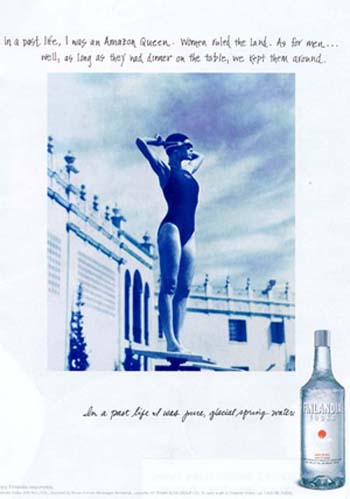
Finlandia, Vogue, 6-99 |
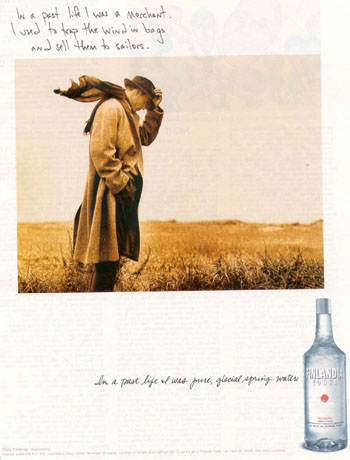
Finlandia, The New Yorker, 11-98 |
|
Discuss the text, visual composition and source of these
Finlandia ads using the following questions:
- Use a Venn diagram to list adjectives describing the
people in the ads. Draw 2 circles overlapping in the middle. In
the right circle list adjectives describing the man; in the left
the woman; and in the common ground in the middle, list adjectives
that might describe them both.
- Compare and contrast your 3 lists. Do your lists reveal common
stereotypes or gender differences between women and men?
- Which person would you like to be and why?
- If the male ad appeared in Vogue, would it be effective
in selling alcohol. Why or why not?
- Write down an argument to show that the fantasies used by advertisers
are constructed to appeal to men and women differently, that is,
people's fantasy lives are gendered, advertisers know this fact,
and use it deliberately.
|
7.
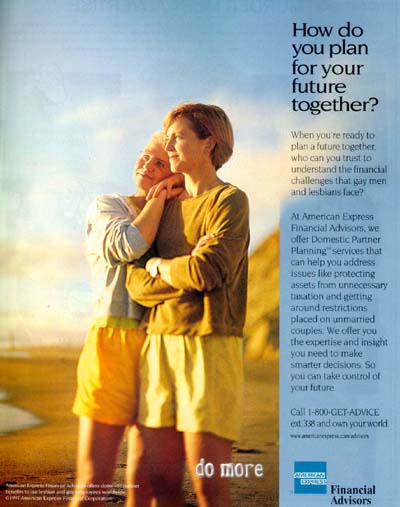
American Express, Out, 8-99 |
Read the copy of this ad for American Express.
- Discuss what the phrase "domestic partner"means.
- Why have some city governments or companies changed
their benefits so that they extend to domestic partners
instead of married couples only?
- What sorts of discrimination are these institutional
reforms addressing?
- Write down a list of forms of discrimination
gay couples face.
|
|
- Discuss what sorts of fantasies this American Express
ad might be appealing to? Will they be endlessly deferred?
Why?
|
|
- Consider why American Express wants its customers
to "do more?"
- Discuss whether that will help lesbian couples
"take control of their future?" .
|
|


8.
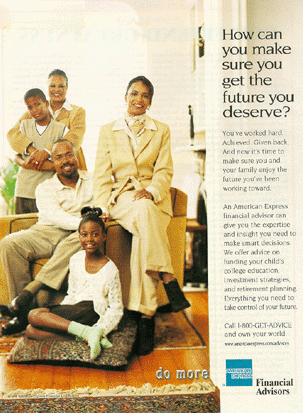 American Express, Ebony, 6-99
American Express, Ebony, 6-99 |
| Discuss comparisons between the American Express ad
directed to lesbian couples (7) and this ad targeted at African
American consumers. For example, how are code words (jargon,
or "buzz words")are used in the ads differently? |
Use media literacy principle five
to analyze this ad and discuss these questions:
- What ways of life are being promoted by the family's surroundings,
clothing, hair styles and demeanor?
- How is the ad consistent with values dominant in our social
system?
- What sorts of invisible ideological messages are present,
i. e., how should African Americans act to achieve their
dreams?
- How does the ad extol the virtues of consumerism and
implicitly recommend "the acceptance of authority,
and unquestioning patriotism".
|
|
 
9
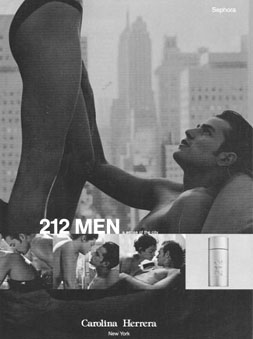
Maxim
|
|
The ad text says: "212 Men: a sense of the city."
Answer these questions:
- Who is the target audience?
- Discuss what dreams are appealed to.
- Use the 6 media questions experts recommend (see USM)
to analyze the ad.
|
|
|
Analyze the ad using the following quote from John Berger:
| The state of being envied is what constitutes glamour. And
publicity is the process of manufacuring glamour. (131) |
What ideological messages does the ad convey.
|
  Send
an example to the class archive! Send
an example to the class archive!
|
|


![]()